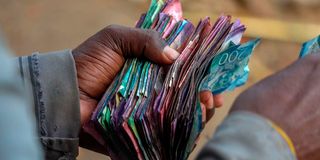Trade takes big dent as shilling hits record low

A trader at Muthurwa market in Nairobi counts the day’s sales in December last year.
What you need to know:
- The Kenyan shilling maintained its slide against the US dollar, dropping to a record low of 126.07 yesterday amid huge dents in the country’s terms of trade (ToT) and debt repayment costs.
- The shilling’s performance means that in less than two months since the start of the year, it has lost 2.14 per cent of its value against the greenback, having traded at a mean of 123.42 units on January 3.
- If you go further back, the local currency has weakened by 11.4 per cent since last January.
The Kenyan shilling maintained its slide against the US dollar, dropping to a record low of 126.07 yesterday amid huge dents in the country’s terms of trade (ToT) and debt repayment costs.
The shilling’s performance means that in less than two months since the start of the year, it has lost 2.14 per cent of its value against the greenback, having traded at a mean of 123.42 units on January 3.
If you go further back, the local currency has weakened by 11.4 per cent since last January.
The poor run of the shilling has heavily hurt the country’s ToT, which represents the ratio between a country’s export prices and its import prices and is a key indicator of its economic health.
Importers of key items including petroleum, grains, electronics, motor vehicles, machinery, food, clinker, pharmaceuticals, and clothing have been hit hard by the weak shilling that has exerted upward pressure on import prices leading to high retail costs.
Official data shows that, between January and November last year, the value of the country’s total imports hit Sh2.29 trillion against Sh804.45 billion for exports—signifying the strain on the economy. The value of imports grew to Sh661.79 billion during the third quarter of 2022 alone, up from Sh541.78 billion — a growth of 22.1 per cent.
Importers high prices
Importers — who are facing difficulties in buying US dollars —are raising prices to offset higher currency costs, which have hit trade as cash-strapped consumers tighten spending. Early this month, Mabati Rolling Mills Chief Executive Officer Manish Mehra said steel prices could go up due to currency issues.
“We could see prices of steel rising in the coming months primarily because of the currency issues that we are facing. The increase will, however, not be as steep as that which we witnessed more than a year ago,” said Mr Mehra. Exporters have however hugely benefited from the weaker shilling that has made their goods more competitive in the global market. Data from the Kenya National Bureau of Statistics shows the value of exports grew to Sh200.46 billion in the three months to September last year compared to Sh159.9 billion in the same quarter in 2021, a growth of 25.3 per cent.
The National Treasury in its Medium Term Debt Management Strategy has tipped exchange rates to stabilise this year supported by a recovery in remittances inflow and tourism revenue as well as the reduced import of capital goods.
“However, there are downside risks to this projection associated with increasing prices of crude oil and delays in full normalisation of the global supply chain,” said the Treasury. Kenya’s foreign debt is also ballooning owing to the weaker currency.
Kenya’s external debt is held in foreign currencies to minimise risk exposure. Currency depreciation increases debt service costs.
The US dollar accounts for 68 per cent of external debt, the Euro 20 per cent, and other currencies account for 12 per cent. The government plans to borrow debt in local currency and diversify foreign currencies when borrowing to minimise foreign exchange risks.





